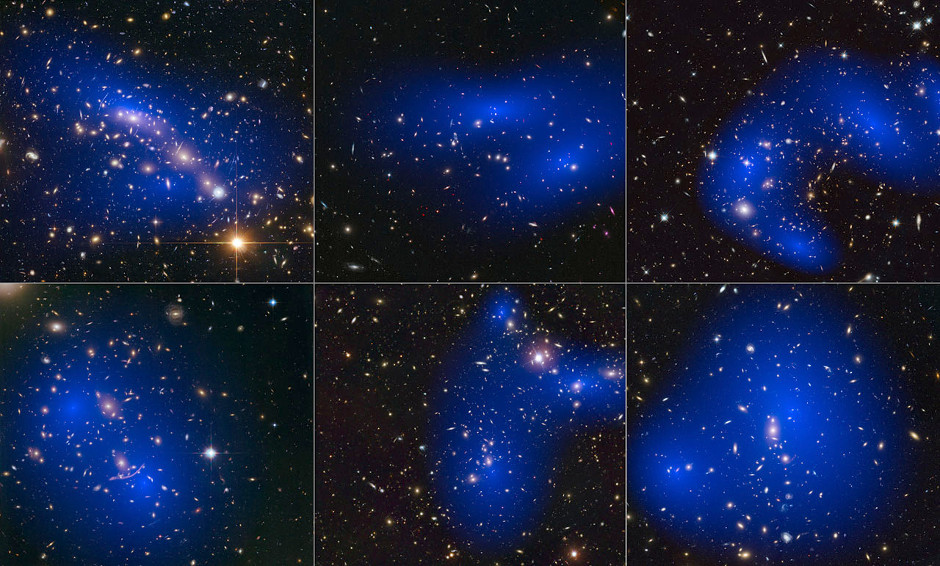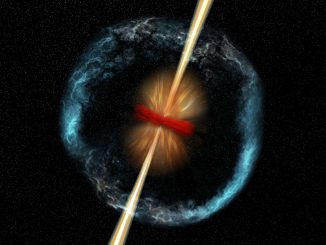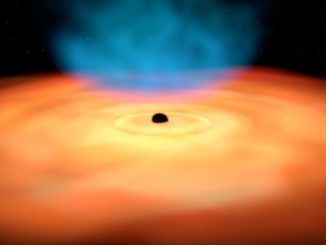
Dark matter is a giant question mark looming over our knowledge of the universe. There is more dark matter in the universe than visible matter, but it is extremely elusive; it does not reflect, absorb or emit light, making it invisible. Because of this, it is only known to exist via its gravitational effects on the visible universe (see, e.g., video).
To learn more about this mysterious substance, researchers can study it in a way similar to experiments on visible matter — by watching what happens when it bumps into things. For this reason, researchers look at vast collections of galaxies, called galaxy clusters, where collisions involving dark matter happen naturally and where it exists in vast enough quantities to see the effects of collisions.
Galaxies are made of three main ingredients: stars, clouds of gas and dark matter. During collisions, the clouds of gas spread throughout the galaxies crash into each other and slow down or stop. The stars are much less affected by the drag from the gas and, because of the huge gaps between them, do not have a slowing effect on each other — though if two stars did collide the frictional forces would be huge.
“We know how gas and stars react to these cosmic crashes and where they emerge from the wreckage. Comparing how dark matter behaves can help us to narrow down what it actually is,” explains David Harvey of the École Polytechnique Fédérale de Lausanne (EPFL) in Switzerland, lead author of a new study.
Harvey and his team used data from the NASA/ESA Hubble Space Telescope and NASA’s Chandra X-ray Observatory to study 72 large cluster collisions. The collisions happened at different times, and are seen from different angles — some from the side, and others head-on.
The team found that, like the stars, the dark matter continued straight through the violent collisions without slowing down. However, unlike in the case of the stars, this is not because the dark matter is far away from other dark matter during the collisions. The leading theory is that dark matter is spread evenly throughout the galaxy clusters so dark matter particles frequently get very close to each other. The reason the dark matter doesn’t slow down is because not only does it not interact with visible particles, it also interacts even less with other dark matter than previously thought.
“A previous study had seen similar behaviour in the Bullet Cluster,” says team member Richard Massey of Durham University, UK. “But it’s difficult to interpret what you’re seeing if you have just one example. Each collision takes hundreds of millions of years, so in a human lifetime we only get to see one freeze-frame from a single camera angle. Now that we have studied so many more collisions, we can start to piece together the full movie and better understand what is going on.”
By finding that dark matter interacts with itself even less than previously thought, the team have successfully narrowed down the properties of dark matter. Particle physics theorists have to keep looking, but they now have a smaller set of unknowns to work with when building their models.
Dark matter could potentially have rich and complex properties, and there are still several other types of interaction to study. These latest results rule out interactions that create a strong frictional force, causing dark matter to slow down during collisions. Other possible interactions could make dark matter particles bounce off each other like billiard balls, causing dark matter to be thrown out of collisions or for dark matter blobs to change shape. The team will be studying these next.
To further increase the number of collisions that can be studied, the team are also looking to study collisions involving individual galaxies, which are much more common.
“There are still several viable candidates for dark matter, so the game is not over, but we are getting nearer to an answer,” concludes Harvey. “These ‘astronomically large’ particle colliders are finally letting us glimpse the dark world all around us but just out of reach.”



